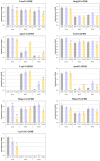Effects of Essential Oil Inhalation on the Enhancement of Plasma and Liver Lipid Metabolism in Mice
- PMID: 40565139
- PMCID: PMC12192594
- DOI: 10.3390/ijms26125674
Effects of Essential Oil Inhalation on the Enhancement of Plasma and Liver Lipid Metabolism in Mice
Abstract
The purpose of this study was to determine the effects of essential oil inhalation on body weight, blood lipid profile, and liver and adipose tissue in mice. Middle-aged male mice (C57BL/6J) were exposed to Lavandula angustifolia (LO) and Citrus aurantium (CAO) essential oils for 7 weeks and compared to mice that did not receive essential oil inhalation treatment. Liver, white adipose tissue, and brown adipose tissue were sampled, kept at -80 °C. Although essential oil inhalation increased feed intake and body weight compared to control group, the amount of weight gain per feed intake was lower in the C. aurantium essential oil group. Moreover, relative weight of fat to body weight, liver fat amount, and blood cholesterol was lower, and triglyceride levels were significantly reduced. Reverse transcription polymerase chain reaction (RT-PCR) expression profiling of genes related to lipid metabolism confirmed changes in the regulation of thermogenesis-related gene Ucp1 and the cholesterol synthesis-related genes Hmgcs1 and Hmgcr. The inhalation of C. aurantium essential oil did not reduce the feed intake in mice; however, its effectiveness in suppressing the increases in body weight and fat mass was demonstrated.
Keywords: Citrus aurantium; Lavandula angustifolia gene expression; anti-obesity; aromatherapy; essential oil inhalation; lipid metabolism.
Conflict of interest statement
The authors declare no conflicts of interest.
Figures






Similar articles
-
[Effects of high oleic and different fatty acid composition edible oils on glucose and lipid metabolism in middle-aged and elderly rats].Wei Sheng Yan Jiu. 2025 May;54(3):419-426. doi: 10.19813/j.cnki.weishengyanjiu.2025.03.010. Wei Sheng Yan Jiu. 2025. PMID: 40550607 Chinese.
-
Changes in the Expression of Some Genes With Metabolic, VLDL and Antioxidative Effects After the Addition of Essential Oil Mixture to Drinking Water in the Liver of Domestic Geese (Anser anser Domesticus).Vet Med Sci. 2025 Mar;11(2):e70285. doi: 10.1002/vms3.70285. Vet Med Sci. 2025. PMID: 40028755 Free PMC article.
-
[Local overexpression of miR-429 sponge in subcutaneous white adipose tissue improves obesity and related metabolic disorders].Sheng Li Xue Bao. 2025 Jun 25;77(3):441-448. doi: 10.13294/j.aps.2025.0039. Sheng Li Xue Bao. 2025. PMID: 40566711 Chinese.
-
A Systematic Review of the Anxiolytic-Like Effects of Essential Oils in Animal Models.Molecules. 2015 Oct 14;20(10):18620-60. doi: 10.3390/molecules201018620. Molecules. 2015. PMID: 26473822 Free PMC article.
-
Exercise-induced effects on UCP1 expression in classical brown adipose tissue: a systematic review.Horm Mol Biol Clin Investig. 2017 Jan 13;31(2):/j/hmbci.2017.31.issue-2/hmbci-2016-0048/hmbci-2016-0048.xml. doi: 10.1515/hmbci-2016-0048. Horm Mol Biol Clin Investig. 2017. PMID: 28085671
References
MeSH terms
Substances
Grants and funding
LinkOut - more resources
Full Text Sources

